
FORD Mustang
Generations Timeline, Specs and Pictures

The original pony car was introduced in late 1964 and just a couple of years later went through some minor modifications.
Joe Oros, the lead designer of the Mustang team, stated once: “I wanted a car to appeal to women, but I want men to desire it, too.” And that was the beginning of one of the most successful cars Ford ever made. The car was introduced in August 1964 with a small engine and a fast-looking image. Later on, the sports car received the engines it deserved.
In 1966, Ford planned the first slight adjustment to the vehicle, including the front end. The original model featured a black grille and, in the middle, the rectangular Mustang’s badge with a running horse, supported by a cross-hair style four elements. In 1966, that detail was changed to a more conservative grille with horizontal slats and a center-mounted rectangular Mustang badge.
Inside, there were two bucket seats and a four-on-the-floor gear-stick. The instrument cluster resembled the front fascia, with two round dials on the outer sides and a linear speedometer between them, and three lamps at the bottom. The car featured another pair of seats in the back, with enough room for a pair of average-sized teenagers. An AM/FM radio was available on the options list.
For the 1966 model year, apart from other engine options, Ford introduced the 6.4-liter V8 unit paired to a 3-speed automatic gearbox.
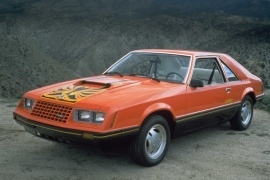
The Mustang’s third-generation covered a wider area, but it was split into a few updates along the road.
In 1981 Ford introduced a turbo version.
After a few oil crises, the customers were concerned only when a crisis started, while the big companies began to be worried all the time. Ford tried to offer both performance and fuel-efficiency in the same package.
The Fox-body Mustang was a love and hate affair for the American carmaker. The former glory now was struggled to keep pace with regular vehicles. But, at least, it looked like it was able to score a ten-second on a quarter-mile run. It’s four, squared headlights next to the raked grille, and the angular look of the greenhouse made a good impression when the Mustang was introduced. While the front was still attractive, the back of the car lost its appeal and featured bland-looking taillights.
Inside, it was no different from most compact-sized vehicles on the market, with a squared look for the instrument cluster and in-dash, buried, dials. The interior styling was influenced by European trends but applied half-way.
The Mustang’s biggest news was the introduction of a turbocharger applied on the base, a 2.3-liter engine. It was a big improvement since it offered a maximum output of 131 hp. At the same time, a 5.0-liter V8 produced a mere 140 hp.
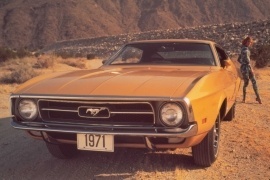
The Mustang got bigger in for the 1971 model, and the carmaker literature appealed to the customers’ memory for the original 1964 model, which was sold in huge numbers.
Ford considered that the original customers were now six or seven years older, and they already had kids and needed a place to seat them. While the original Mustang had a minimal room in the back, the 1971 model offered enough for teenagers. Unfortunately, the ‘71 Mustang didn’t live too long. New emission and insurance regulations and CAFE agreements put an end to the muscle car era, and the original pony-car was no longer a pony.
Its long hood and sloped roofline ended with an almost flat windscreen left a sports car’s impression. Ford even said that the design was inspired by European sports cars. The spoiler under the front bumper, the flush door handles, and the wing on the trunk somehow confirmed those statements. But the size and the car’s weight were on the other end of the scale.
Inside, Ford installed high bucket front seats with integrated headrests. They could tilt and slide forward to make room for rear passengers. The dashboard was rear raked and slightly curved. In front of the driver, the carmaker installed the essential dials that showed the speed, the fuel level, and a big clock. Surprisingly, there was no tachometer for that sports car.
Under the hood, Ford offered the Mustang a choice of two engines paired either with a four-speed manual or a four-speed automatic. But customers went on buying smaller cars. As Lee Iacocca said, “The Mustang market never left us; we left it.”

The 1970 Mustang was produced in a very small number, especially the Boss 429 version built in around 500 units.
The muscle-car war was on, and all the carmakers had something to say in that. Even smaller manufacturers started to interfere with the Big-Three, such as the AMC. Ford Mustang was still a fierce competitor, and the blue-oval brand tried to keep its coupe ahead of the pack with yearly upgrades. In 1970 it introduced the Boss version and made some changes to the bodywork.
For starters, it dropped the four-headlights look and pushed them inside the grille, which was wider. From its sides, its specific fake air-intakes in front of the rear wheel arches were deleted. In the rear, the Mustang kept the three vertical taillights, but they were protruding again. Unlike the fastback version, the coupe featured a three-box design but a very sloped rear window and a wide C-pillar. Its rear quarter panels were widened and curved.
Inside, the car was kept simple, almost spartan-looking. A round knob shifter was used for the manual versions, while a T-type with push-button was used for the automatic transmission. Some vehicles were featured the Hurst shifter, especially for the Boss 301 versions. The upholstery was only black or white leather. A special version, named Grande, featured a vinyl roof and high-back bucket seats, along with a thicker carpeting and race-style door-mirrors.
Under the hood, Ford installed seven engine choices, starting with a small inline-six. At the other end of the scale was the ultra-rare Boss 429 V8. The carmaker installed a 3-speed manual, a four-speed manual, or a three-speed automatic depending on the engine.

Ford introduced a vital upgrade for the Mustang in 1968.
It was the year when the carmaker took its gloves off and started to punch the other muscle-car producers.
In 1967, the muscle-car era was at its height, and cars like the Pontiac GTO or Dodge Charger started to get more attention on the drag-strips. Ford was losing at its game, and surely it didn’t want that. But the carmaker had a few aces on its sleeves and introduced an updated version for the 1967 and 1968 model year. That included larger engines, some exterior modifications, and interior improvements. It was also the car that starred in the famous chase from Bullit against a Dodge Charger.
On the outside, the carmaker installed side-scoops and chrome side ornaments. At the front, the famous Mustang badge was not supported by horizontal slats. It was just bolted onto the grille. In the rear, there were concave taillights that made the car looks sportier than the original version.
Inside, the carmaker had to do some modifications according to the new safety rules, including the seatbelts. There was a new, two-spoke steering wheel with an energy-absorption steering column. Along with these improvements, Ford started to offer new interior colors for the upholstery.
Under the hood, Ford went all the way and installed a big-block V8 engine, which put down over 400 hp for the top version. On a car of that weight, and with an improved suspension, the Mustang regained its place on the racetracks.
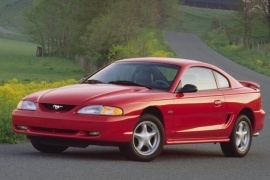
In 1996 Ford retired the old 302 ci (3.94 CMC) engine from the Mustang GT. It was produced for more than three decades, and the new 4.6-liter was better.
The Mustang’s third generation was introduced in 1993, and it came right after the Fox-body Mustang, a car that almost ruined the nameplate. But Ford recovered well and introduced a car that changed the course of the pony-car.
First of all, the fourth-generation Mustang was the first that was not available as a sedan anymore. It was built only as a fastback (hatchback) or convertible. Unlike its predecessor, it was designed with curved lines and swept headlights. The black, trapezoidal grille featured the silver running horse in the middle. The carmaker installed a small wing in the back and a special set of light-alloy wheels with five spokes instead of the previously used three, double-spoke, ones on the GT version. The taillights featured three vertical lamps instead of the previously used three horizontal ones. It was closer to the original 1964 ½ design.
Inside, the Mustang GT featured leather upholstery and front bucket seats with higher bolstering on the sides. The six white dials on the dashboard and the design inspired by two-seat race-cars made the car more appealing. It was not a revolution on the inside since Ford put its efforts into the drivetrain.
There was a completely new engine with OHC (on-head cams) instead of the older pushrod system under the hood. It offered the same power and torque as its predecessor, but it was lighter. The front suspension was improved with the addition of a reinforcing cross-car brace between the struts towers. From the performance-wise, it was not such a big gain, but the fuel-efficiency was increased.
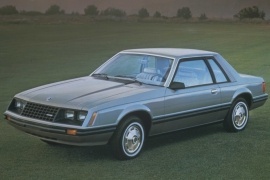
Ford built the Mustang’s third generation as a car that would appeal to a wide range of buyers, developing a niche segment.
Back in ‘79, the number one criteria for the coupe buyers was the styling. Ford threw away the former plans of building large, curved fenders and gave the car a wedged look. On the other hand, it tried to sell the Mustang as a daily-driver sports-coupe vehicle. While the daily-driver and the coupe criteria were achieved, the sports part lacked the stamina.
Ford developed the Fox platform, which led to the Fox-body’s nickname for the third generation of the Mustang. It featured four square headlights and a raked grille in front of the radiator. The car was available as a 2-door coupe or a 3-door hatchback. While the former was ended in a short decklid, the latter featured a sloped tailgate. It was noticeable the small window behind the doors and the thick C-pillar.
The interior was disappointing for customers due to its family-car design. A wood-trim on the dash-panel looked more appropriate for a sedan than into a sports-car. Fortunately, Ford decided to install a full set of dials and gauges, including amp-meter, oil-pressure, coolant-temperature, tachometer, and a speedometer. At least, the Mustang offered good space for the driver and the front passenger. There was not too much room in the back, but that wasn’t important for a coupe.
Under the hood, Ford installed a four-pot engine for the base model, a V6 as an intermediate one, and a V8 for the top version. Soon after its launch, the carmaker started to have trouble with the V6 unit’s supply and replaced it with an inline-six.
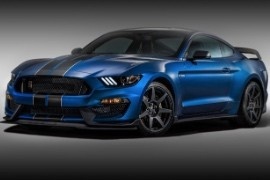
Based on the 2015 Ford Mustang GT350, the GT350R takes it up one more notch for track-day enthusiasts by bringing more racing oriented parts.
The exterior is improved through a front lower air splitter, a rear difusser, vented hood for heat extraction and lift reduction, underbody belly pans, vented wheel wells, different side skirts as well as a rear wing. The deletion of the air conditioning system stereo, rear seats, trunk floorboard and carpet, backup camera, exhaust resonators and the extensive use of carbon fiber makes the car a lot lighter than the standard GT350.

The all-new, most powerful naturally aspirated Mustang Shelby GT350 broke cover on the Internet just before the 2014 Los Angeles Auto Show.
It was the car that broke the 100 hp/liter barrier for naturally aspirated Ford engines. The 5.2-liter unit offered 533 hp and 581 Nm (429 lb-ft) of torque. It was mated exclusively with a 6-speed manual.
The look was different than the rest of the Mustangs. The front fascia was completely different. Ford installed different front fenders, a bigger bumper, and larger ai-scoops. The car featured MagneRide adaptive dampers and the whole vehicle was stiffer by 26 percent compared to a regular Mustang. It could be ordered in different trim levels and one was for the hard-core enthusiast who would have to take it to the racetrack. The R-version didn’t have an AC-unit and not even a radio. What it has was carbon-fiber wheels, reinforcement brackets between the shock-absorbers towers and only two seats. The rear ones were removed.
Performance-wise, the Shelby GT350 was a masterpiece of its creator. The 0 to 100 kph (0-62 mph) sprint was obtained in 4.4 seconds and the top speed was close to 250 kph (155 mph). But the most important part of the game was that it was very fast on the track, not only on straight-line acceleration.
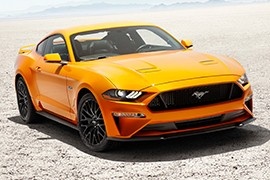
The legendary Ford Mustang was the inventor of the pony car segment.
After years of misunderstanding the market, the Blue Oval brand finally made it. And it was a hit.
The retro-design look resembled the original 1964 Mustang. The three vertical taillights, the fastback shape, and the long hood were all part of the tasteful design. The front of the car didn’t adopt the round headlights as in the original model, but the designers did a better job than that. The flat-hexagonal grille was complemented by the silver running horse that evokes the origins of the car.
Inside, there were four seats but due to the greenhouse shape and front seats, it was a limited space. For the driver, Ford installed an infotainment system named SYNC 3, which could be paired with a smartphone. The toggle switches on the central console looked very good, as another touch of retro-design.
For the drivetrain, the Ford Mustang offered three engine choices: a 4-cylinder turbocharged, a 3.7-liter V6 and a 5.0-liter V8. The four-pot and the V8 were available in Europe while the V6 not. The standard transmission was a 6-speed manual, but a 6-speed automatic was available. The good thing is that the 2017 Mustang was available only with four-wheels independent suspension, which made the car better on corners, unlike some previous generations that had a live axle to propel the vehicle.
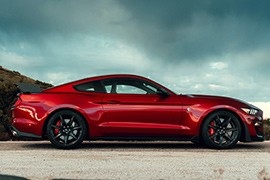
Based on the latest-generation Mustang, the all-new Shelby GT500 is the most powerful production Shelby model ever created.
It also comes with the quickest acceleration and highest horsepower numbers ever offered on a street legal Ford Mustang with factory parts. Designed to offer supercar performance on an even higher level than the “base” Shelby GT350 Mustang, the new GT500 is also fitted with the quickest-shifting transmission ever offered on a Mustang.
Under that long sculpted hood sits a hand-built 5.2-liter aluminum alloy V8 that’s mildly based on the Shelby GT350s Voodoo engine, only in this case the flat-plane crankshaft has been replaced with a more traditional cross-plane design. The 760 horsepower and 625 lb-ft of torque are attainable thanks to a massive 2.65-liter roots-types supercharger with an air-to-liquid intercooler.
Both the supercharger and the intercooler are integrated neatly inside the V of the engine for improved response and low-down torque. All that power is sent exclusively to the rear wheels through a Tremec dual-clutch transmission with 7 forward speeds that can shift gears in just under 100 milliseconds.
As expected from a sports car of this caliber, there are various driving modes available, including normal, weather, sport, drag and track, not to mention a line-lock feature or launch control, all of them available through selectable Track Apps in Ford’s uConnect infotainment system.
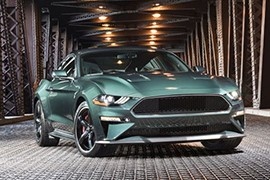
Have you seen the movie “Bullitt”? Well, if you’re not familiar with the car chase, at least now you know where the nameplate comes from.
We could say that the Bullitt was the upgraded version of the GT model, however, it was more than that. The Bullitt could easily compete with a Dodge Challenger and a Chevy Camaro. Why? Because the Bullitt was a combination between the two: a grand tourer with muscles.
The Mustang’s Bullitt could be visually differentiated from the GT and the EcoBoost versions by the exterior paint color. Customers had only two colors to choose between, green (not an ordinary green, you should see the movie!) and black. Other visual differences consisted of the 5-spoke alloy wheels, the Brembo callipers and the chromed grille.
You would not see the Mustang badge anywhere outside or inside the Bullitt, as it was replaced by the Bullitt logo (of course).
The cabin of the Bullitt was pretty much similar to the Mustang’s other versions, however, it had a cue ball shifter and an aluminum bezel. The users could opt for Recaro seats.
The 12-inch display was used to configure the car’s driving modes, to be clearer, the steering, the suspension and the exhaust sound. While the users could switch between different driving modes, they could also add a personalised one. For example, as the exhaust was pretty loud, users could choose to start the car in a quiet mode. Sure, quiet was not exactly the right words for the 5.0-liter V8 with 480 hp.
And overall, $61.000 seemed like a good price for what the Bullitt offered.

The Mustang is one of the best-known vehicles from the blue-oval brand.
In 2014, the sixth generation of the original pony-car was launched and it was the first Mustang to be sold worldwide.
The history of the Mustang goes back to ’60s when John Oros, a designer who’s parents emigrated from Transilvania (Romania) draw the concept and won the internal design challenge with his team. In 1964 the first final model rolled out the factory and started its life as the 1964 ½ model. The rest was history.
Mr. Oros passed away in 2012, but his design concept lived on in the 2014 model, with the retro-design look of the vehicle. The initial idea was to draw “a car that the ladies would love that the men would love just as much”. The long hood, sloped cabin, and aggressive look were the strong points in the car’s design.
The fastback version of the original Mustang was the favorite for car-enthusiasts. The 2014 coupe was available only as a convertible and a fastback-coupe. The long, sloped roof was ended into a small rear spoiler. It was the original pony-tail that was kept and used. The three angled lights featured on the 1964 Mustang found their way on the DRL upfront inside the headlights and on the rear taillights.
The interior had the classic look with modern necessities. When compared with the convertible version, the coupe offered more legroom for the rear passengers, but less headroom. Ford installed all of its new features for the Mustang, including its SYNC3 infotainment system.
At the time of the launch, there were three engines available: a 2.3-liter four-pot, a 3.7-liter V6, and a 5.0-V8 engin
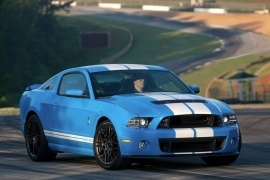
The 2013 model-year Ford Mustang Shelby GT500 was made to go where no other Mustang has gone before, boasting a 662 bhp engine and reaching speeds of more than 200 mph.
This was done using a larger and more efficient supercharger along with an updated cooling system, camshaft profile, bigger bore, redesigned connecting rods, upgraded carbon fiber driveshaft, revised gears and other little technical changes regarding the car’s handling. Design enhancements include all-new signature lights with two LED bars, a high gloss rear panel between the taillamps, new rims, improved aerodynamics, new front spoiler and more.

An American favorite, the legendary Ford Mustang managed to survive through the years, with the first model being released back in the 60s’.
The muscular exterior design was well appreciated, however, the Mustang lacked a refined handling or a top-notch interior quality, compared to competitors like the Mazda RX-8 and the Nissan 350Z.
For 2009, the Mustang was available as a coupe or a convertible and came in four trim levels: V6 Deluxe, V6 Premium, GT Deluxe and GT Premium,
The base model, the V6 Deluxe included 16-inch alloys, cruise control, air-conditioning and keyless entry, while the V6 Premium added a power driver seat and an updated audio system.
The GT Deluxe trim level came with bigger 17-inch alloys, a rear spoiler, foglamps and sport seats.
The top of the range, the GT Premium added leather upholstery and a premium audio system.
Standalone options included 18-inch alloys, xenon headlights, remote ignition, ambient lightning and a new glass roof.
Safety wise, the Mustang came with standard front-seat side aribags and 4-wheel disc brakes. Optionally, buyers could choose antilock brakes and a traction control system, features that were standard on the GT trim level.
The interior looked a bit dated for 2009 and the quality of materials made the car feel cheap, with hard plastics all around.
The Mustang could accommodate up to four people, however, the rear space was cramped. The trunk was a decent size.

Ford and Carroll Shelby joined their forces one more time to create the most powerful Mustang to date: the GT500.
Carroll Shelby and Ford didn’t join their forces from the beginning. Their connection started after the legendary driver took an AC chassis and dropped a 221 ci engine in it. Later on, Ford asked Shelby to built them a winning car for LeMans, and he did. The rest is history, and the Shelby snake badge was placed only on high-performance vehicles.
The GT500 featured a more aggressive look with the silver snake badge on the black front grille. To make room for the supercharged V8 engine, the car featured a wide dome on the hood with three extracting vents on it, needed for cooling. A special aerodynamic package with a lower lip spoiler, side sills, and a duck-tail on the trunk lid completed the image.
To keep its occupants fixed, Ford Mustang Shelby GT500 featured a pair of bucket seats for the front passengers. The dashboard featured a new infotainment unit on the center stack, while for the instrument cluster, there was a complete package with six analog dials.
Ford Mustang GT500 featured a supercharged V8 engine paired to a heavy-duty 6-speed manual gearbox. SVT engineers retuned and upgraded key chassis components, which made the car corner faster. They stiffened the suspension, revised spring rates, and improved the five-link rear solid axle.
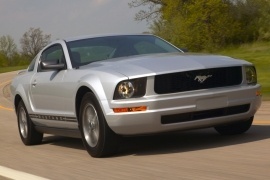
The fifth generation of the Ford Mustang was unveiled in 2004 for the 2005 model year in coupe and convertible body versions.
There are just a few iconic American cars in automotive history: Jeep, Ford Mustang, and Chevrolet Corvette. While the Jeep was the only real off-road contender in the U.S. market, the other two claimed their trophies on the drag-strips and many races around official tracks. While the Corvette evolved as a supercar, the Mustang was the affordable sports car built as a comfortable daily driver and, in some versions, a fierce contender on handling tracks.
Ever since its introduction in 1964, the original pony-car was famous for its rear-cab design. Over time, its fame star started to vanish, but the 2004 model might be considered a true rebirth of the iconic coupe. Like its predecessor, it was not available as a three-box version anymore.
The design team took its inspiration from the original version and adopted the round headlights. Like the original ‘Stang, the 2005 model featured a flat, vertical front fascia with a black grille and separate headlights casings. As an option, the fog-lights were installed in the grille. From the sides, the roofline followed the same line as the original fastback version from the late ’60s. In the back, the three vertical taillights followed the same retro-design pattern.
Inside, there was more of a modern design than the retro-inspired one but still kept the chromed rings around the tachometer and speedometer. Ford installed up to date bucket seats with headrests and a wide center console with cup-holders. In the back, there was a bench for not too tall passengers.
For the initial launch, the Mustang featured only a 4.0-liter and a 4.6-liter V8 engine choice.

In December 1998, Ford introduced a significant facelift for the fourth generation of the Mustang, which included a redesigned body and upgraded powertrains.
Ford introduced the new-edge design theme in the automotive arena. The refreshed Mustang had a more masculine look with the introduction of the new design elements. Unfortunately, the American carmaker didn’t want to get rid of the solid rear axle, which was way obsolete for a 1999 sports car.
While the 1994 ‘Stang didn’t feature any straight line on its bodywork, the ‘99 model was almost the opposite. Angular headlights and taillights, sharp edges on the hood and sides, plus an extravagant fake air-intake on the rear fenders. But some would notice the same greenhouse design and, for the Cobra versions, the dome on the hood.
Inside, the rounded lines were still there, with a wave-like dashboard that resembled the original design of the 1964 ½ Mustang panel, but with a deep center stack extended to the center console. The front bucket seats were built for comfort, but the carmaker offered a pair with higher bolstering as an option. In the back, there was slightly room for two adults, but with minimal headroom. Since the rear axle was nowhere near the comfort zone, every bump on the road could have lead to brain damage.
Ford installed the 3.8-liter V6 engine for the base model mated to a 5-speed manual gearbox under the hood. Its power was increased by 45 hp when compared to its predecessor and reached 190 hp. For the 4.6-liter V8, the power was raised from 215 hp to 260 hp. Later on, the Cobra version provided up to 320 hp from the same unit.

Some Mustangs made history for their performance or their looks, but the 1978 Mustang made it into the books for its short-lived production time.
The second generation of the Mustang was about to die, and its successor was on the pipeline. But Ford still had to sell the car, even though it was not that appreciated by its fan-base since it was based on the infamous Pinto platform. The Mustang 1978, with its King Cobra version, was not the same thing as the rest of the range.
While it looked more like a stretched Pinto than a fastback Mustang, the King Cobra featured some specific design elements. Moreover, it was available as a targa body version, which was considered nicer than the regular, rag-top versions. Its sloped rear end with a tailgate that opened the trunk caused a mixed feeling among its regular customers. But the nicest part of the car was the hood, with its dome in the middle.
Inside, the car featured sport-bucket seats for the front occupants and a bench good only to store a sandwich. Ford designed the car to be useful as a commuter car, not a long-travel cruiser. Its wheelbase was way too short for that.
Under the hood was one of the lowest-power 5.0-liter engines from its times. The V8 unit provided three ponies less than the European BMW 323, which featured a 2.3-liter displacement. But Ford tried to convince people that the car was sporty and could handle better than its competitors.

Once again, Ford increased its pony-car’s size, the Mustang, and offered new drivetrains that helped the car keep-up with the Dodge Challenger and Chevrolet Camaro.
The glorious era of muscle-car was at its heights, and behind all the marketing strategies, everything was down to the midnight races and the quarter-mile time. All the carmakers knew that a powerful vehicle would sell better than another, and the image of a “daytime cruiser and night-time racer” was the one that sold more than anything else, especially in the coupe-segment.
Ford designers imagined a new front fascia that featured two additional headlamps included in the grille’s outer sided. Suddenly, the Mustang had a night-time signature image, apart from the running horse badge. The fastback version sported two air-intakes on the rear quarter panels and made the car looks meaner. And, above them all, stood the Boss 429 version with an advertised 375 hp engine.
Inside, the dashboard was heavily modified and sported a four-dials instrument cluster. The dashboard was still looking like two separated parts, bonded together via a center stack. Its sport-bucket seats at the front were standard, and the rear bench was straightforward to remove.
For the drivetrain, Ford installed a choice of three engines, plus the special versions such as Mach 1, Boss 302, and Boss 429. The latter featured a Nascar engine, and it was a street-legal drag racer.

While it was still part of the Mustang’s first generation, the 1972 Coupe looked different, in a more GT-style look.
In the late ’60s, the Muscle-car era was at its heights, and other carmakers offered cars that could outrun the Mustang. It was time for something bigger and powerful, but the original ‘65 vehicle couldn’t handle larger engines. After several modifications, the 1972 Coupe was introduced in 1971 with a wider body to accommodate the 7.0-liter engine (429 ci). Unfortunately, Ford axed that engine for the 1972 model.
The design team tried to follow the original fastback design, with a wave-like beltline. Due to cost-cutting reasons, the side sculptured panels were simpler than before, ruining the original effect. Another cost-cutting measure was the vertical rear window, placed between longer body panels, which mimicked the wide B-pillars from its predecessor.
Due to the larger body, the interior was wider. The instrument cluster was far from the original design and showed a more conservative look with round dials, and some versions didn’t even feature a tachometer. It was clearly a car built to compete on the GT segment but wearing the Mustang badge on it.
In 1972, Mustang lost the big-block engine and remained with the 5.8-liter unit as its most powerful version. In the top-spec version, it was still fast, but not the beast it used to be.

The Mustang was the original pony car, and it was one of the most important nameplates in Ford’s heritage, and the 1965 fastback was an inspiration for many generations of car-enthusiasts.
To build the car, the engineering team and designers alike burned the midnight oil and finished the project in just 18 months when there were no computer-aided-design techniques. The result exceeded the expectations since it started a new car-segment.
Joe Oros designed the Mustang sedan with two doors and regular, three-box bodywork. Then, he secretly created the fastback, cast it in fiberglass, and showed it to Iacocca. The Big Chief agreed, and the legend was born. Joe Oros originated from Europe and had different ideas. He wanted the car to have a different stance and a unique front fascia. That’s how the Mustang badge appeared on the grille and not the blue-oval. The round headlights were positioned a little bit backward than the grille. As a big difference apart from the regular coupe version, the greenhouse featured a sloped rear window and thick B-pillars with air-vents. Due to its sculptured side panels, the Mustang showed like no other American car on the road. For the 1965 model, Ford installed a specific badge behind the front wheels, on the fenders.
Inside, there were two bucket seats and a four-on-the-floor gear-stick. The instrument cluster resembled the front fascia, with two round dials on the outer sides and a linear speedometer between them and three lamps at the bottom. The car featured another pair of seats in the back, but they were so cramped that they could hardly be taken by anyone else than a toddler in a jumpsuit.

Ford introduced the original Mustang GT350 Shelby in 1965 together with the legendary Carroll Shelby and the first car with the Cobra name on its engine.
Introduced in late 1964, Ford Mustang quickly found its way on the market and launched the pony-car era. While small engines powered the base versions, the 1965 Mustang GT350 came to fix that and offered a NASCAR vehicle for road use.
The car featured a lighter hood made out of fiberglass instead of pressed steel, and even if the two-stripe design was very common, it was a dealer option, not from the factory. Even though the Mustang was available in three body versions, the GT350 was produced only as a fastback. It still featured the same front design, but with a few enhancements. Its horse-badge was installed on the left side, and it was smaller than the chromed badge with a mustang in the middle of the radiator’s grille. On the front fenders, there was a small GT 350 badge.
Inside, a pair of race-bucket seats were fitted for the front occupants, and there were no rear seats. Instead of those, there was a fiberglass shelf for the spare wheel. The dashboard featured an additional pod that hosted an oil-pressure dial and a tachometer with a read-line at 6.500 rpm.
Ford Mustang GT350 Shelby featured a 4.7-liter (289 ci) with a four-barrel carburetor that sent the power to the rear wheels via a 4-speed manual. Despite its simple suspension system, the Mustang GT350 Shelby was a very efficient track-car with front independent type and a live rear axle. Ford offered it even with a special competition package.

Despite not being the best-sold vehicle nor the fastest Ford, the Mustang might be the most iconic car ever built by the American carmaker.
The original Mustang came on the market in 1964, and it was the original pony-car, hands down. It was born as a project for a personal luxury coupe in the project “Allegro.” The Mustang name came after one of the designers, Philip T. Clark, saw wild mustangs in Nevada. He designed the logo and presented it to Lee Iaccoca, who embraced the name and the idea to have a specific badge on the car.
Lee Iaccoca imagined the Mustang as a personal vehicle. It featured two round headlights and a pushed-out grille. Thanks to its long hood, the 2+2 cabin, and the short deck, the Mustang fired-up people’s imagination. The carmaker installed a set of air-intakes in front of the rear wheels to cool the drum-brakes. In the back, designers placed three vertical taillights, which eventually became notorious.
Inside, there were two bucket seats and a four-on-the-floor gear-stick. The instrument cluster resembled the front fascia, with two round dials on the outer sides and a linear speedometer between them, and three lamps at the bottom. Since it was a three-box design with a regular shape for the greenhouse, there was an adequate headroom for two passengers.
Under the hood, Ford installed a choice of engines starting with an inline-six that provided just 100 hp, and it was paired to a 3-speed manual gearbox. Later on, after media and customers praised the car, the American carmaker introduced another two V8 engines.























































